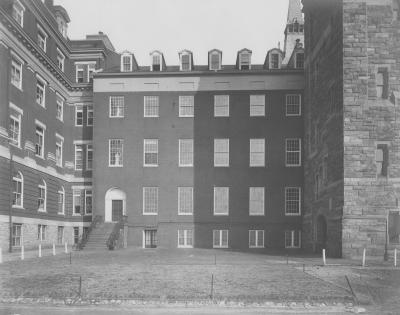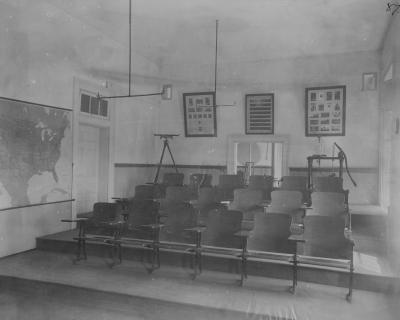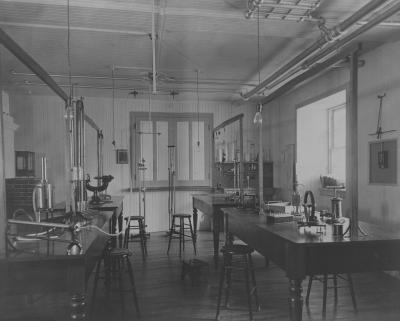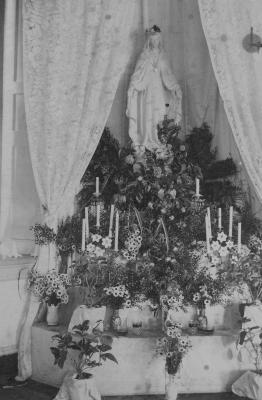Maguire Hall is an administrative building, formerly used for classrooms. Built from 1854 - 1855, it has witnessed a number of important historical events relating to both Georgetown and the United States. It currently houses the Office of Communications, the Georgetown Business Ethics Institute, the Office of Planning and Institutional Research, and the Office of Training and Organizational Development. Maguire comprises 18,404 square feet.
Design and Construction
Maguire's original interior supports were made of wooden beams with some iron columns. The original construction featured no fireplaces, thus it is unknown how the building was heated. Although chimneys existed, these may have been for ventilation or merely ornamental. It is possible that heat from nearby buildings was piped in.
Maguire originally served as the Junior Student Building for younger students at Georgetown Academy (the predecessor of Georgetown Preparatory School). The basement was used for recreation, the first floor had a dining room as well as a reading and music room, the second floor was used for study, while the third and fourth floors were open dormitories. The fourth floor also featured an infirmary.
Building Use
Beginning in 1878, the building came under the control of the Physics Department, which by 1911 was using the entire first floor with a lecture room, cabinets, two shops, and a laboratory.
In 1919, the Georgetown Academy left Maguire for its current site (under the name Georgetown Preparatory School) in Rockville, Maryland.1
At one point it was customary for student mail deliveries to be announced from the steps of Maguire Hall, though this had ended by 1927.2
In 1931, the graduate division of the School of Foreign Service moved into offices on the second floor of the building.3
The University's Radio Club, formed in 1937, was located in Maguire. In its early days, club members practiced Morse code transmission in Maguire as well as organizing guest lectures on radio phases. Advanced members worked on constructing an oscillator and repairing amplifying equipment for converting light waves into sound waves.4 In 1938, the Club built an amateur radio station in the basement of Maguire.5
The senior dining room on the first floor became a reference room for Riggs Library in 1960, which was then split into four classrooms in 1970.6
In 1971 at least some of the building was being used for offices. Fine Arts Professor Leonard Cave's office was located on the second floor, and was robbed of a $600 statue in late March, 1971.7
In 1973, in response to a larger than expected number of female students in need of housing, the formerly male fourth floor dorm in Maguire became a female dorm.8
The shift to administrative use began in 1983, when both the third and fourth floor were turned into offices. In 1990 the remaining floors became offices as well.
Historical Events
During the early part of the Civil War, federal troops in the New York 69th Regiment were quartered in Maguire and Old South and were reviewed by President Abraham Lincoln on May 8, 1861.
After the second Battle of Bull Run in Manassas, casualties were brought to Maguire to be treated by the Army Medical Corps. Additional casualties were brought in after the Battle of Antietam. Georgetown billed the government $7,500 for expenses, which was rejected, an event that was seen as increasing southern sympathy on campus.
In 1911, Father Tondorf, S.J., a professor of biology and physiology as well as Regent of the Medical school, placed a seismograph in Maguire that registered the Great Kantō Earthquake in Japan on September 1, 1923.9
Father Bernard Maguire, S.J.
The building is named for Father Bernard Maguire, S.J. (1818 - 1886), who was twice president of the University: from 1853 - 1858 and again from 1866 - 1870. He was also an alumnus of the University.
- 1Francis X. Ballman, "Maguire Hall," Building Outlines Campus Buildings, 1789 – 1995, Father Lawrence Hurley Memorial Edition, Francis X. Ballmann and the Division of Facilities, 1995, pp. 57 - 58.
- 2"Philodemic's Ninety-Eighth Year," The Hoya, October 13, 1927, Vol. IX No. 5, p. 2. http://hdl.handle.net/10822/1041331
- 3"Foreign Service Grad School Opens," The Hoya, November 4, 1931, Vol. XIII No. 6, p. 1. http://hdl.handle.net/10822/1047462
- 4"Radio Club Formed by Students with Aid of G.U. Faculty," The Hoya, December 17, 1937, Vol. XIX No. 9, p. 8. http://hdl.handle.net/10822/1047627
- 5"Much Interest Shown in New Radio Club," The Hoya, January 19, 1938, Vol. XIX No. 11, p. 1. http://hdl.handle.net/10822/1047629
- 6Francis X. Ballman, "Maguire Hall," Building Outlines Campus Buildings, 1789 – 1995, Father Lawrence Hurley Memorial Edition, Francis X. Ballmann and the Division of Facilities, 1995, pp. 57 - 58.
- 7Art Wheeler, "Fine Arts Dept. Hit by $600 Burglary," The Hoya, April 22, 1971, Vol. LIV No. 23, p. 3. http://hdl.handle.net/10822/555366
- 8"Women to Occupy Fourth Healy, Maguire," The Hoya, September 2, 1973, Vol. LVI No. 1, p. 2. http://hdl.handle.net/10822/555417
- 9Francis X. Ballman, "Maguire Hall," Building Outlines Campus Buildings, 1789 – 1995, Father Lawrence Hurley Memorial Edition, Francis X. Ballmann and the Division of Facilities, 1995, pp. 57 - 58.







